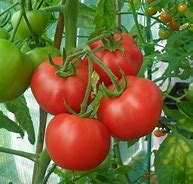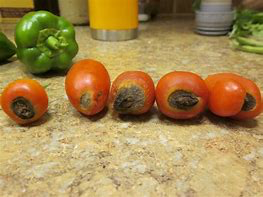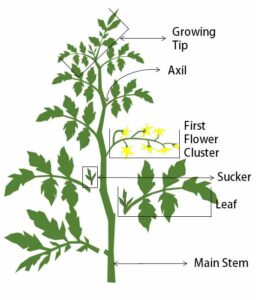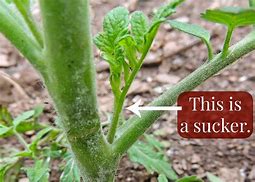“There ain’t nothing better in life than true love and a homegrown tomato” — Folk saying
Another truism: yes, botanically, tomato is a fruit. Specifically, it’s the edible berry of the tomato plant. However it is a “culinary vegetable” because of how it’s used as a food — which comes from the fact that it is more “savory” than sweet.
A cautionary note: Our region of the Pacific Northwest is one of the most difficult parts of the continental U.S. for growing tomatoes. Tomatoes don’t grow well until the overnight soil temperature is at least 65 degrees Fahrenheit, and that doesn’t happen until well into our growing season.
For some additional information, click here for a link to the 2022 presentation by Grace Ellen Miller, a local gardening expert and employee of Portland Avenue Nursery, on techniques for growing tomatoes in the Pacific Northwest.
Benefits and nutritional information:
- Tomatoes are juicy and sweet, full of antioxidants, and may help fight several diseases.
- They are especially high in lycopene, a plant compound linked to improved heart health, cancer prevention, and protection against sunburns.
- Nutritional benefits aside, tomatoes are one of the most popular crops simply because they are so delicious and so versatile. And there is absolutely no comparison between a vine-ripened tomato and the kind carried in grocery stores that are picked green and “ripened” with ethylene gas.
Starting:
- The first step in starting tomatoes is to decide which ones to plant. In any seed catalog there are dozens of types to choose from — heirloom tomatoes, various cultivars, cherry tomatoes — all with different qualities of size, color, growth pattern, disease resistance, flavor and so on. Some varieties are favored as “slicers,” others for sauce.
- There are two major categories of tomatoes:
- Determinate tomatoes ripen over a short period of time. Basically, you only get one crop. Determinates develop a more bush-like growth pattern.
- Indeterminates ripen over a longer part of the growing season. They have a vine-like growth pattern and definitely need to be trellised.
- Tomato cultivars vary widely in their resistance to disease.
- Modern hybrids focus on improving disease resistance over the heirloom plants.
- Various forms of mildew and blight are common tomato afflictions, which is why tomato cultivars are often marked with a combination of letters that refer to specific disease resistance. The most common letters are:
- LB – late blight,
- V – verticillium wilt,
- F – fusarium wilt strain I,
- FF – fusarium wilt strain I and II, and
- A – alternaria.
- Tomatoes started from seeds need to be grown in trays 6 to 8 weeks before anticipated transplant date. They should be transferred into 3 to 4 inch pots when the first set of true leaves appear.
- Prior to planting a tomato seedling, place a handful of bone meal or other source of calcium in the bottom of the hole and mix with the soil. This may prevent blossom end rot later.
When to plant:
- Tomatoes may be planted out when the soil temperature reaches 65 degrees.
- They may be planted sooner than that, but roots don't develop well.
- They have difficulty absorbing nutrients,
- The plants will show deficiencies. New growth is very slow, if it occurs at all.
- They may have increased susceptibility to blossom end rot.
- You don't gain anything from early planting in the open ground! Good advice is to be patient, check overnight soil temperature before planting. Here in DuPont this can be well into the gardening season.
- On the other hand, some people manage to cheat the system by creating a miniature greenhouse effect with various covers/soil caps.
- Another solution may be to continue to grow them in ever larger containers until well into the warm weather before transferring them into outdoor beds.
- In any cases, when transferring seedlings from a warmer setting to a cooler one the plants need to be hardened off in ensure their survival.
- A common recommendation is to bury the plant more deeply in the soil than the crown since the portion of the stem now in the soil will develop additional roots.
- This recommendation needs to be tempered by the fact that the deeper something is planted, the longer it will take for the roots to enjoy overnight temperatures of 60 degrees.
- One tomato expert claims to manipulate the system by planting the roots horizontally just below the surface and then gradually bending the plant’s stem upward to a vertical position.
Thinning, training
- Determinate tomatoes, bush like in shape, can be spaced 18 to 24 inches apart; indeterminate, vine growing tomatoes, from 24 to 36 inches apart.
- Tomatoes — especially indeterminate — should be trained onto a trellis. Most convenient and most often a metal tomato cage. This develops a larger, healthier plant, increasing the amount of air flow throughout the foliage to reduce susceptibility to diseases.
- Pruning out non-productive shoots keeps your plants from using up space and nutrients that could otherwise go into producing fruit. [see last section on this page for detailed description]
 Signs of over-watering, nutrient deficiency
Signs of over-watering, nutrient deficiency
- Overwatered tomatoes develop cracks in the fruit.
- Tomatoes need frequent fertilizing throughout the season in order to do well.
- However, fertilizers that are high in nitrogen may result in a plant with lush foliage and few if any tomatoes. Excess nitrogen may also contribute to blossom end rot.
Pests and pest controls
- Early and late blight, bacterial spots, mosaic virus, fusarium wilt, etc. Controlling these diseases is mostly a matter of prevention: selecting disease resistant varieties, trellising and pruning to allow for good air circulation, monitoring for infestations and immediately cutting out and disposing of diseased stems and branches.

- Verticillium Wilt is easy to confuse with blight, except that Verticillium Wilt generally takes place later in the season. Because the fungus causing Verticillium Wilt is so persistent in the soil (4 to 5 years), crop rotation can’t be counted on to control it. Instead, the most feasible and economic control is to plant Vedrticillium-tolerant cultivars.
- Blossom end rot can cause heavy losses in crop yield. Traditionally, this has been considered a nutritional problem but recently it’s been argued that planting tomatoes before the soil has warmed up sufficiently is the major cause. Insects don’t tend to be as much of a problem on tomatoes as are diseases.
- Flea beetles will cause some damage, but we don’t have problems, such as tomato hornworms, that other areas of the country have.
- Birds will often damage the ripening fruit by pecking holes in it to obtain a drink of water.
Harvesting
- Every season, a significant amount of produce is wasted by gardeners failing to harvest their crops when they ripen. This is especially true of cherry tomatoes which require frequent picking.
- Gardeners who can’t devote sufficient time to monitoring and harvesting their crops should make arrangements with a fellow gardener to help them out.
- Tomatoes can be harvested prior to being fully ripe, picking them when the first light blush of color appears on the skin. They can then be allowed to ripen indoors. Wrapping them in newspaper will help them ripen faster since it contains the ethylene gas produced by the tomato which helps ripen it.
- On the other hand, a vine-ripened tomato generally has a much superior flavor since it’s had more time to develop sugars and flavor-producing compounds.
- A tomato ready to harvest will easily come off in your hand. Grasp the fruit firmly, but gently, and pull from the plant by holding the stem with one hand and the fruit with the other, breaking the stalk just above the calyx that has formed to protect the bud.
- Do not refrigerate tomatoes after picking them. It degrades their flavor.
PRUNING TOMATOES
This section is only for those growing indeterminate tomatoes — the varieties which produce new leaves and flowers throughout the growing season. Pruning determinate varieties only results in a decreased harvest.
Benefits of pruning:
- With fewer leaves, the airflow through the plant is enhanced and they are less susceptible to disease. This is especially true outdoors where the upper portion of the plant gets wet in the rain and needs to dry out faster.
- Pruning at the right time can result in larger fruit by directing the plant’s energy toward creating and ripening fruit instead of making more leaves.
- Pruned plants can be placed closer together and thereby giving room for more plants. This helps make up for any loss of fruit caused by pruning off branches.
- With fewer leaves to take care of, fruit can ripen faster. This helps in our very short season climate where getting a tomato harvest often becomes a race against time.
How to prune
- The initial pruning should take place at the time of planting. Removing the lower leaves allows the plant to be put more deeply into the soil. It also keeps developing leaves further up from the soil level which helps resist pest infestation.

Image from ofags.com/how-to-prune-tomatoes - Any flowers present at planting time should also be removed to allow the energy to go into leafy growth and root growth at this early stage. Continue to remove flowers until plants are 12” to 18” tall.
- Remove all leafy suckers beneath the first fruit cluster so they don’t take energy from fruit development. Remove them with a sharp knife or pruner blade, making a clean cut as close to the main stem as possible without damaging stem tissue.
- As the plants grow taller, remove all leaves within 12” of the ground to maintain airflow and cut down on the chance of disease.
- Toward the end of the growing season, you can speed up the ripening of remaining fruit by pruning off the growing tip of each main stem. This “topping” causes the plant to stop flowering and setting new fruit and instead directs all sugars to the remaining fruit.




